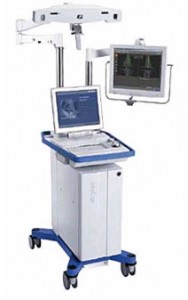Computer navigation in knee replacement surgery – how does it work?
As the term suggests this technique utilizes the services of a computer to help the surgeon navigate during surgery. It works on the principle of Global Positioning System (GPS) in much the same way as the GPS guides a driver navigate roads while driving a car. Just as a satellite is used to track the position a car, similarly in computer navigation an infra-red camera is used to track the markers (reflectors) which are temporarily attached around the patient’s knee. After putting these markers the surgeon puts the knee through different motions. This allows the computer to compute the axial alignment of the patient’s leg. The patient’s unique bone morphology (size and shape) is then fed into the computer using a special probe which is moved on the exposed bony surface. On the basis of this data, the computer generates an image showing the alignment of the leg and a three dimensional model of the patient’s knee. The surgeon thus has greater visibility during surgery. The computer will show the projected alignment of the limb at every step of the surgery and alert the surgeon of any deviation from the desired alignment. The combination of this enhanced visibility and guidance along with specialized instrumentation allows the surgeon to position the implants with greater precision.
Infrared camera sensing the markers on the knee and alignment of the leg
Bony surface being mapped out using a probe
Images displayed by the computer with implants in place
Advantages of Computer Navigation
The success of any knee replacement surgery depends on the alignment of the limb and the stability of the joint. The ideal alignment is to have the centre of the hip, knee and ankle joint in a straight line (Hip-Knee-Ankle – HKA axis should be zero degree). The alignment one achieves depends upon the accuracy of bone cuts and the stability of the joint depends on the ligament (soft tissue) balance achieved.
In the conventional knee replacement technique bone cuts are made using mechanical devices called jigs. It has been reported that with the conventional technique it is possible to align the implants to within 7 to 9 degrees of optimal alignment. Computer navigation allows the implants to be aligned to within 3 degrees of the optimal alignment. Thus computer navigation allows the implants to be positioned more accurately.
Another benefit of using computer navigation is that it avoids the use of intramedullary jigs (introduction of a rod inside the femur to align the bone cuts to get the desired alignment) which is routinely used in the conventional technique. This is said to minimize the incidence of fat embolism syndrome (globules of fat released into blood circulation can cause blockages in the lungs). Computer Navigation technology with its enhanced visibility also facilitates use of this technology in technically difficult procedures like unicompartmental knee replacements, hip resurfacing surgery and minimal invasive hip and knee replacement surgery.
What is current status of computer navigation in knee replacement surgery?
At the present time computer navigation is in use mainly for knee replacement surgery. It is widely accepted that computer navigation increases the accuracy of alignment of the leg after total knee replacement. However it is not yet proven conclusively if this translates into a better clinical result especially with regard to the longevity of the prosthesis. Further, using computer navigation adds to the cost of the procedure and duration of surgery. At the present time most surgeons feel that without any conclusive evidence to suggest that computer navigation gives superior results, it is not absolutely necessary to advocate its use in routine practice.




